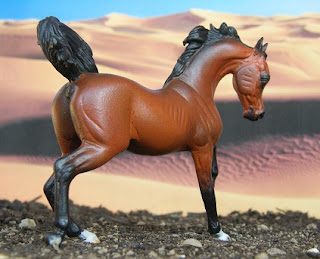No, I'm kidding, don't worry. It's not actually that hard once you get the hang of it, but it takes some practise and lots of time to complete a piece.
Anyway, this post is a guide to dappling the model horse. The piece I will be using to show you the dappling process is a nice classic scale 'Arielle' resin sculpted by Carol Gasper. She is a vintage resin from 1994 (I think, not entirely sure about her release date). First off, *many* things went wrong with prepping and painting this piece... Firstly, when I got her, she was 90% prepped - her previous owner had done a great job sanding down seams and filling holes. So all I had to do was sand her over once more and spray her with primer. Here's where the trouble begins: I got my light grey primer and started spraying, but it was finished before I could finish spraying her. In a cabinet in the garage I found another grey spray which I though I could use.
HOWEVER, the spray turned out to be a silver-ish metallic grey - not in the slightest what I wanted! To make it worse, the spray reacted badly with my normal primer, so I had to run and try to wash off the silver primer before the model was completely ruined... It worked (sort of) but it left me with a load of sanding work...
When I finally had her prepped again, I just 'primered' her with a layer of chestnut coloured acrylic paint thinned down with water. Then I put some dark brown/black shading on her and began the graying process.
After that long story, we can now finally get on with dappling the horse :P I create my dapple greys using mixed media in the old-school way.
Before starting:
FIRST THING you have to do when you want to create realistic dapples is to find a good reference picture! Very important! No dapple greys are exactly alike, so make sure that you have good reference pictures of real horses.
Then you will also need a set of *very* thin brushes to paint the dapples with. Depending on the scale you're working in, choose a set of brushes that you think are tiny enough.
The paints you will need are: black, white, brown (depending on wether you're going for a chestnut/bay or black based dapple grey, choose a lighter or darker brown colour). Pearl paints can work well on a dapple grey, but only use them in some areas. I don't use any pearl paints on my pieces as I don't feel comfortable working with them.
To create my dapple greys, I use not only acrylic paints but also some pastels. I only use white, light grey and a dark grey. Black is too heavy and will often leave grainy spots on the model when used over acrylic paint.
Dappling the Dapple Grey:
Step 1: Scrub thin white or light grey acrylic paint in the areas where the dappling is dense and where white areas exist. This is usually on the flanks, belly, head and part of the legs. On my model, also the neck is quite a light grey colour. Make sure you don't scub the white in the dark areas on the horse! The darkest areas are usually the knees, shoulders, back and butt. You *can*, however, scub a tiny bit of white over the dark areas to make the difference less stark. In the picture below you can see that I did that on the shoulder.
Step 2: Get some pure white paint and start painting dapples on the horse. Keep your reference pictures close! Make sure you paint dapples of different shapes and sizes. Randomize the pattern to keep it realistic.
 |
| Random dappling on the neck. Don't worry about the dapples looking unnatural, we will fix that later. |
 |
| Close up of dappling |
 |
| Dapples blended in and facial shading applied |
 |
| Preparing the shoulders for dappling |
 |
| More dapples |
 |
| Dapples, dapples, DAPPLES! |
The next part is coming soon! We will get into facial details, dappling the darkest parts and details on the legs like spider-webbing. Exciting stuff! :D





















